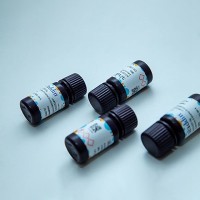Methods for Studying the Interaction of Barnase with Its Inhibitor Barstar
互联网
419
Barnase is a 110-residue extracellular ribonuclease produced by Bacillus amyloliquefaciens . The same organism produces an 89-residue polypeptide, barstar, which binds tightly to barnase and inhibits its potentially lethal RNase activity inside the cell. The three-dimentional structures of barnase and barstar are known both from X-ray crystallography and NMR spectroscopy (1 –4 ). The crystal structure of the complex of barnase with the barstar (C40A/C82A) double mutant has been solved by Guillet et al. (1993) 6 at 2.6 � resolution and by Buckle et al. (1994) 5 at 2.0 � resolution (5 ,5 ). Both barnase and barstar have proven to be excellent models for protein stability and folding studies (7 –11 ). The two proteins form a very tight complex, with K d =10−14 M , half-life of about 2 d and an association rate constant of 4�108 M −1 /s. The kinetic and thermodynamics of the barnase-barstar interaction were investigated in detail (12 –20 ). High affinity is maintained at pH 7.0–9.0, while lowering the pH to under 4.5 eliminates binding completely. The plentiful structural and thermodynamic data available for this interaction, the ease of genetic manipulation and expression, and the excellent in vivo selection methods have made this interaction a target for many genetic selection techniques. Because free barnase is toxic, organisms expressing it can survive only if barstar is efficiently coexpressed. This positive selection system has been used as a convenient tool for transcriptional studies in plants. For example, the tissue specificity of the TA56 promoter was mapped by expressing a TA56/barnase fusion gene in tobacco plants and determining which tissues showed a requirement for barstar production (21 ).Using a similar approach, a transgenic maize plant was developed where a plant with the barnase gene is pollen-sterile, whereas a plant with the barnase and barstar gene is pollen-fertile.








